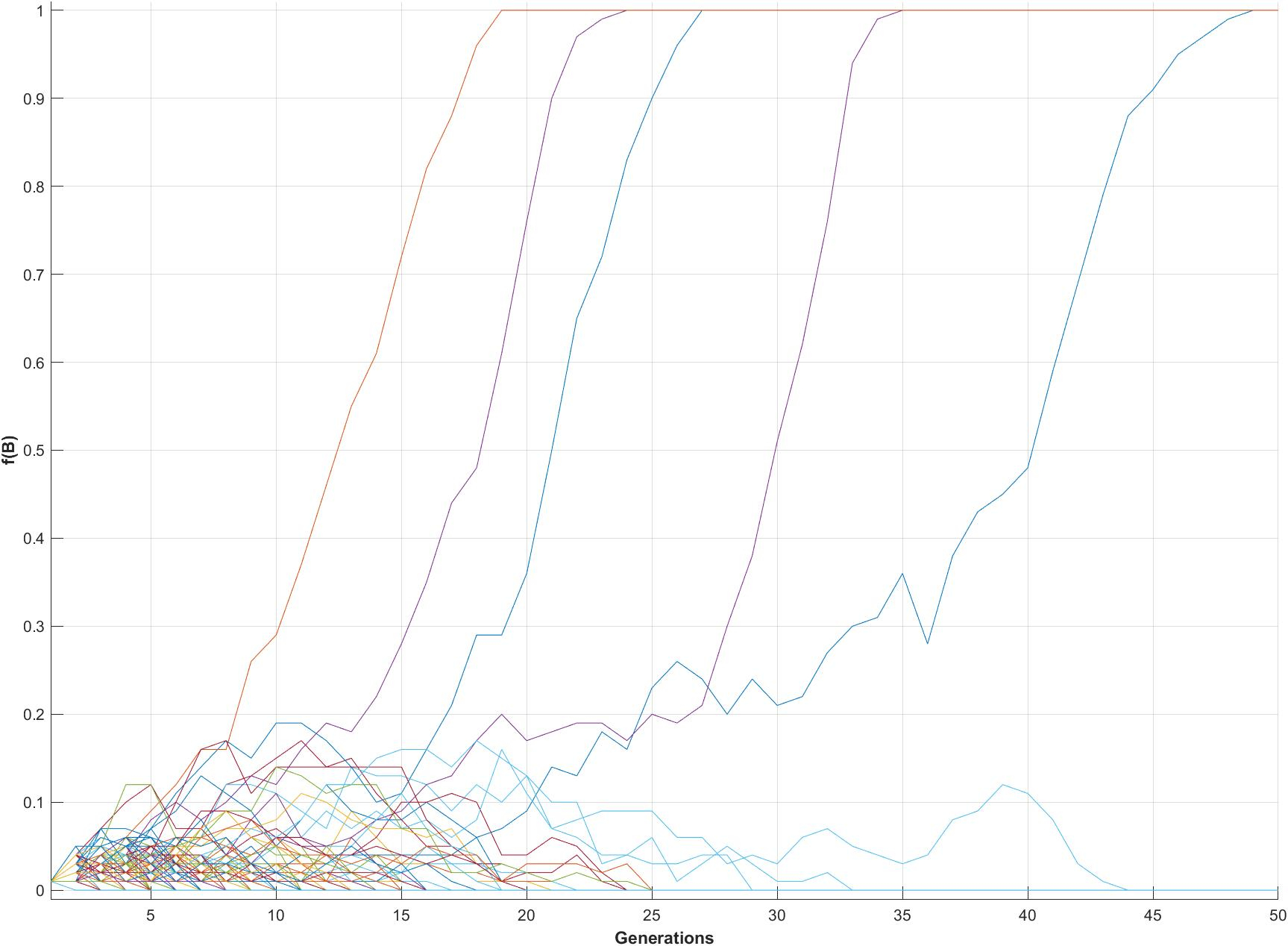
Fixation of a rare advantageous alleles: Modes of genetic speciation
(N = 50, q = 0.01; W0 = 0.5, W1 = 0.4, W2 = 1; 100 replicates)
Advantageous alleles arise occasionally in
a population by new mutation. Even with a major selective
advantage, most such variants never become common, and
disappear in a few generation. This is because a rare
advantageous recessive allele B rarely occurs in BB
genotypes, where the fitness advantage would make a
difference. Further, because a
single new mutant allele occurs at an initial f(B)
= 1/2N, random loss by genetic
drift has greater influence than the selective
advantage. Rarely, and depending on population size and the
degree of selective advantage, such an allele may drift to a
critical frequency, at which point the selective advantage
drives it rapidly to fixation.
In the example shown, among 100 replicate populations with N = 50, a single new variant occurs in a population at f(B) = (1)/(2)(50) = 0.01. The BB genotype has a two-fold selective advantage over AA. The new variant has lower fitness in heterozygous combination AB. In almost all replicates, f(B) 0 without reaching f(B) ~ 0.2 (20 copies of the new variant). When f(B) ~ 0.2, f(BB) = 0.22 x 50 = 2, which means there is an expectation of two BB individuals in the population. The selective advantage of BB causes f(B) to increase rapidly, reaching fixation between t = 18 ~ 48 generations in five populations, while the variant in the other 95 populations has been lost.
One mode of Allopatric speciation is Peripatric speciation, where in small populations on the periphery of a large central population, new alleles that confer a selective advantage in a novel adaptive environment become fixed. This might occur in small island populations separated from a mainland, where conditions on the islands different greatly from each other and from the mainland. Darwin's Finches or the different forms of Galapagos Tortoises are examples.
HOMEWORK: Use the WriFish MatLab program to repeat the simulation above. Are the same results obtained every time? Is there a critical value of W2 with respect to W1 for routine fixation of ca. one population in a thousand (what is the ratio)? Is heterozygote disadvantage (W1 < W0 << W2) critical to the model (try W1 = 0.3, 0.4, & 0.5)? Adjust N and q to correspond to one variant in 5 or 500 individuals: can the same phenomenon be achieved?
In the example shown, among 100 replicate populations with N = 50, a single new variant occurs in a population at f(B) = (1)/(2)(50) = 0.01. The BB genotype has a two-fold selective advantage over AA. The new variant has lower fitness in heterozygous combination AB. In almost all replicates, f(B) 0 without reaching f(B) ~ 0.2 (20 copies of the new variant). When f(B) ~ 0.2, f(BB) = 0.22 x 50 = 2, which means there is an expectation of two BB individuals in the population. The selective advantage of BB causes f(B) to increase rapidly, reaching fixation between t = 18 ~ 48 generations in five populations, while the variant in the other 95 populations has been lost.
One mode of Allopatric speciation is Peripatric speciation, where in small populations on the periphery of a large central population, new alleles that confer a selective advantage in a novel adaptive environment become fixed. This might occur in small island populations separated from a mainland, where conditions on the islands different greatly from each other and from the mainland. Darwin's Finches or the different forms of Galapagos Tortoises are examples.
HOMEWORK: Use the WriFish MatLab program to repeat the simulation above. Are the same results obtained every time? Is there a critical value of W2 with respect to W1 for routine fixation of ca. one population in a thousand (what is the ratio)? Is heterozygote disadvantage (W1 < W0 << W2) critical to the model (try W1 = 0.3, 0.4, & 0.5)? Adjust N and q to correspond to one variant in 5 or 500 individuals: can the same phenomenon be achieved?
Figure & Text material © 2025 by Steven M. Carr